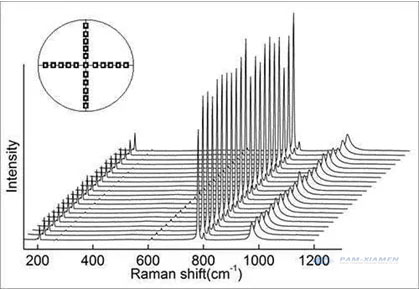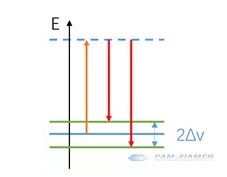Silicon carbide has a variety of crystal types, but the silicon crystal structure the market needed is mainly 4H-SiC. So the silicon carbide crystal growth in crystal types is a defect. To a certain extent, it can be distinguished by the naked eye. A more accurate measurement method for testing the silicon carbide crystal distribution is Raman spectroscopy: Raman spectroscopy has characteristics for crystals, and the peak positions of the light emitted by different crystals are different.
1. What is Raman Spectroscopy?
En 1928, el científico indio Raman descubrió la dispersión Raman en el experimento de estudiar el espectro de dispersión del benceno líquido. La espectroscopia de dispersión Raman, en términos simples, es que usa un haz de luz incidente sobre una sustancia, la frecuencia de la luz incidente es v, y la frecuencia de la luz dispersada resultante será v, v + Δv1, v-Δv1, v + Δv2, v-Δv2, etc. Estos Δv1, Δv2, etc. Δv tienen características. En otras palabras, cada sustancia tiene una cierta diferencia (posición de pico, intensidad de pico), que se llama cambio Raman (la luz emitida menos la luz incidente).
Por ejemplo, el espectro Raman de 4H-SiC es:
| Cambio Raman (cm-1) | Onda acústica transversal E2 | Onda acústica transversal E2 | Onda acústica transversal A1 | Onda acústica transversal E2 | Onda acústica transversal A1 | Onda acústica longitudinal A1 | LOPC | LOPC |
| 4H-SiC | 194.958 | 204.034 | 610.031 | 776.489 | 796.861 | 963.106 | 964.769 | 994.643 |
The table above shown here is the Raman shift. During the silicon carbide crystal distribution measurement, the computer will help to calculate it and process it as a Raman shift spectrum.
2. How to Test the Silicon Carbide Crystal Distrubution?
Las condiciones de prueba típicas son: utilizando el láser de 532 nm del láser Ar + del espectrómetro LabRAM HR Raman, incide verticalmente, la potencia de excitación es de 200 mW y el modo de recogida de luz dispersa es el modo de retrodispersión. La luz incidente con diferentes longitudes de onda tiene diferentes profundidades de penetración. Generalmente, el láser de 266nm es de 0,2 um, el láser de 325 nm es de 2 um y el láser de 514 nm es de 30 um, lo que significa que la luz ultravioleta solo se puede utilizar para medir muestras delgadas.
Because the silicon carbide wafer has different positions, multiple measurements will be taken to obtain the silicon carbide crystal distribution:

The data has three indicators: the position of the peak, the height of the peak (light intensity), and the width of the peak. Only when the peak position is completely matched, can it be el 4H-SiC calificado. Como ocurre con la XRD, siempre que hay otros picos, son sustancias de otras fases, lo cual es un defecto.
The difference in the position of the peak is due to the difference in the energy of the phonons brought about by the different silicon carbide crystal lattices, that is, the different frequencies. Each phonon has its corresponding energy level. The virtual energy level theory can be used to explain Raman (non-linear process):

La partícula absorbe la luz incidente hasta el nivel de energía virtual (naranja) y luego regresa a un nivel de energía vibratoria (rojo) que es diferente del nivel de energía original. Debido a que el nivel de energía superior es un nivel de energía virtual, la frecuencia de la luz incidente se puede variar, siempre que no entre en conflicto con el nivel de energía real original.
Vale la pena señalar que el modo LOPC (964.769 cm-1) se puede utilizar para analizar la concentración de portador:
n = 1.25 * 1017cm-2 *(964.769cm-1-VLOPC measurement)
As the carrier concentration increases, the interaction between atoms and the lattice increases, which makes the Raman peak blue shift (smaller), the intensity decreases, and the width increases. This method is not as accurate as other methods and can only be used as an aid to analyze the silicon carbide crystal distribution.
3. Why not Use XRD to Measure Silicon Carbide Crystal Distribution?
X-rays are optical radiation generated by the transition of electrons in the inner layer of atoms under the bombardment of high-speed moving electrons, including continuous X-rays and characteristic X-rays. Silicon carbide single crystal can be used as X-ray gratings, and the coherent scattering produced by these large numbers of particles (atoms, ions, or molecules) will cause light interference, increasing or decreasing the intensity of scattered X-rays. Due to the superposition of scattered waves from a large number of particles, the beams that interfere with each other to produce the highest intensity are called X-ray diffraction lines.
Para cumplir con las condiciones de difracción, se puede aplicar la fórmula de Bragg: 2dsinθ = nλ.
El rayo incidente hace que cada dispersor vuelva a irradiar una pequeña parte de su intensidad como una onda esférica. Si los dispersores están dispuestos simétricamente con el intervalo d, estas ondas esféricas solo se sincronizarán en la dirección en la que su diferencia de longitud de trayectoria 2dsinθ sea igual a un múltiplo entero de la longitud de onda λ. En este caso, una parte del haz incidente se desvía en un ángulo de 2θ, lo que producirá puntos de reflexión en el patrón de difracción.
Use X-rays of known wavelengths to measure the θ angle to calculate the interplanar spacing d, which is used for X-ray structure analysis; the other is to use a silicon carbide seed crystal with a known d to measure the θ angle to calculate the characteristic X-ray wavelength, and then the elements contained in the sample can be found in the existing data.
The measurement formula is 2dSinθ=λ. While the d value among the cubic silicon carbide crystal is close, and the characteristic is not obvious enough, the accurate silicon carbide crystal distribution cannot be precisely determined. For these reasons, it is not suitable to use the XRD to measure the distribution of silicon carbide crystals.
Para obtener más información, contáctenos por correo electrónico a victorchan@powerwaywafer.com y powerwaymaterial@gmail.com.

